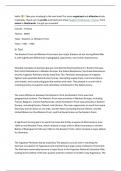Hello ! Take your studying to the next level! For more organized and effective study
materials, check out my profile and flashcard shop Maggie's Flashcards - Payhip. From
notes to flashcards, I've got you covered!
Course : History
Theme : WWII
Topic : Eastern vs. Western Front
Years : 1941 - 1945
In Text
The Eastern Front and Western Front were two major theaters of war during World War
II, with significant differences in geography, opponents, and civilian experiences.
Notable examples of partisan groups included the Soviet partisans in Eastern Europe,
the French Resistance in Western Europe, the Italian Resistance, the Greek Resistance,
and the Yugoslav Partisans led by Josip Broz Tito. Partisans were groups of irregular
fighters who operated behind enemy lines, disrupting supply lines, communications,
and morale, and conducting guerrilla warfare and raids. They played a crucial role in
resisting enemy occupation and ultimately contributed to the Allied victory.
The main difference between the Western Front and Eastern Front was their
geographical location. The Western Front was primarily in Western Europe, including
France, Belgium, and the Netherlands, while the Eastern Front was primarily in Eastern
Europe, including Russia, Poland, and Ukraine. The main opponents on each front were
Germany and its allies on one side, and the Allies (including France, Britain, and the
United States) on the Western Front, and the Soviet Union on the Eastern Front.
A significant turning point on each front was the D-Day invasion of Normandy in June
1944 on the Western Front, which marked a major shift in Allied momentum, and the
Battle of Stalingrad in February 1943 on the Eastern Front, which marked a major defeat
for Germany.
The Yugoslav Partisans led by Josip Broz Tito played a crucial role in resisting the
German occupation of Yugoslavia and maintaining a large-scale resistance movement.
The Partisans eventually became a major force in the Yugoslav National Liberation War,
leading to the defeat of the Axis powers and the creation of modern-day Yugoslavia. The
, Eastern Front was considered more brutal and devastating due to harsh weather
conditions, widespread destruction, and high casualty rates.
Civilians in both fronts suffered greatly during World War II. In Eastern Europe, many
were caught in the middle of the conflict and suffered under Soviet repression and
German occupation. In Western Europe, civilians formed resistance movements to fight
against German occupation, engaging in acts of sabotage, intelligence gathering, and
guerrilla warfare.
In Western Europe, notable examples of resistance movements included the French
Resistance in France, Belgium's White Brigade, and the Dutch Resistance. The French
Resistance aimed to resist German occupation and work towards liberating France from
Nazi rule. Women played a significant role in the French Resistance, often taking on
dangerous tasks such as providing intelligence and participating in sabotage
operations.
The leader of the French Resistance was not a single individual but rather a
decentralized and fragmented movement. Charles de Gaulle was a prominent leader of
the Free French Forces and later became President of France.




